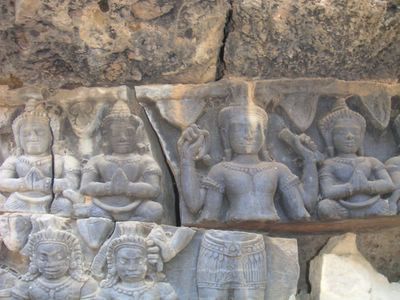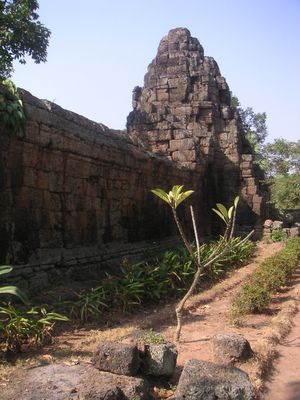What Price on History?
More scenes from Ta Phrom:

Copyright Tan and Trev 2005

Copyright Tan and Trev 2005

Copyright Tan and Trev 2005

Copyright Tan and Trev 2005
Given the pounding Cambodia experience in its turbulent history, we were puzzled as to certain treasures could have survived the destruction of the Khmer Rouge.
For instance, why did the rich tiles of the Silver Pagoda still in place? Or why do ancient buildings like Ta Phrom still stand?
Our guide said the answer was quite simple. The Khmer Rouge had a public image to protect among the international community, despite its attempts to isolate Cambodia from the rest of the world. So they kept the Silver Pagoda as a token conservation effort, just in case foreign dignitaries might want to visit it.
Even today, there is a big business in the up-keep of bygone items.
And Cambodia is not adverse to the idea of earning a little profit by leasing chunks of itself to foreign corporations to maintain (while also in harvesting tourism dollars).
For instance, this week the 'Killing Fields' gravesite were privatized in Cambodia.

Copyright Tan and Trev 2005

Copyright Tan and Trev 2005

Copyright Tan and Trev 2005

Copyright Tan and Trev 2005
Given the pounding Cambodia experience in its turbulent history, we were puzzled as to certain treasures could have survived the destruction of the Khmer Rouge.
For instance, why did the rich tiles of the Silver Pagoda still in place? Or why do ancient buildings like Ta Phrom still stand?
Our guide said the answer was quite simple. The Khmer Rouge had a public image to protect among the international community, despite its attempts to isolate Cambodia from the rest of the world. So they kept the Silver Pagoda as a token conservation effort, just in case foreign dignitaries might want to visit it.
Even today, there is a big business in the up-keep of bygone items.
And Cambodia is not adverse to the idea of earning a little profit by leasing chunks of itself to foreign corporations to maintain (while also in harvesting tourism dollars).
For instance, this week the 'Killing Fields' gravesite were privatized in Cambodia.
”The mayor of Phnom Penh says a Japanese company, JC Royal, has signed a 30-year deal to manage the Cheoung Ek "Killing Fields" genocide memorial on the outskirts of the capital.Link
The firm will have to plant trees and flowers at the site, which is home to a memorial tower of 8,000 human skulls, as well as build other visitor facilities.
In return, JC Royal will be able to charge foreign tourists a fee to enter the site.



0 Comments:
Post a Comment
<< Home